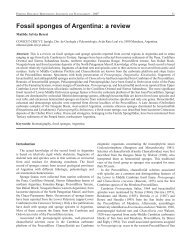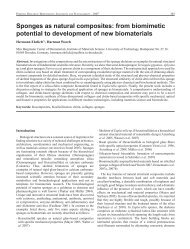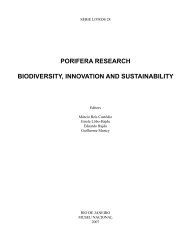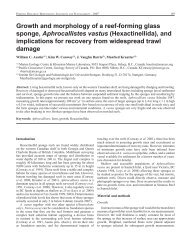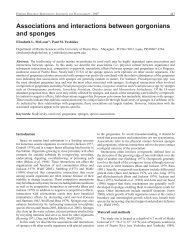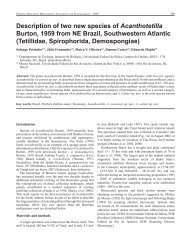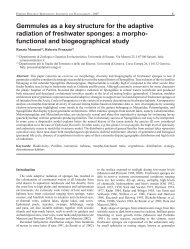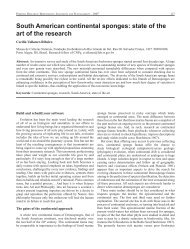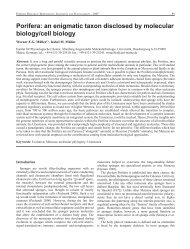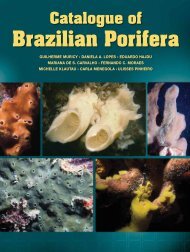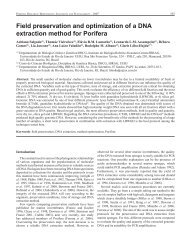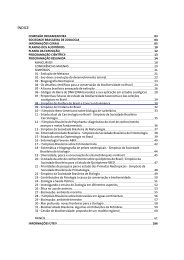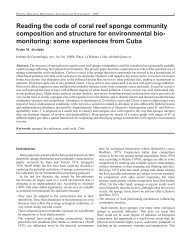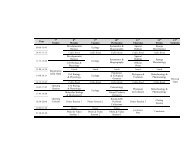Symbiotic relationships between sponges and other ... - Porifera Brasil
Symbiotic relationships between sponges and other ... - Porifera Brasil
Symbiotic relationships between sponges and other ... - Porifera Brasil
You also want an ePaper? Increase the reach of your titles
YUMPU automatically turns print PDFs into web optimized ePapers that Google loves.
148<br />
Material <strong>and</strong> methods<br />
Specimens of the three associations were collected by<br />
SCUBA diving from 2 to 12 m depth, in four localities from<br />
the Sea of Cortes (Eastern Pacific Ocean, Mexico) (Fig. 1).<br />
We followed the techniques described by Rützler (1974) for<br />
spicule <strong>and</strong> tissue preparations for light microscopy. Crosssections<br />
of the specimens were washed in distilled water<br />
<strong>and</strong> then dried on a cover glass <strong>and</strong> coated with gold for<br />
scanning electron microscope (SEM) observations. A number<br />
of 20 to 50 spicules chosen r<strong>and</strong>omly were measured (length<br />
x width) from each of the specimens studied. The number<br />
<strong>between</strong> brackets in each description is the average. After<br />
the description, the specimens were fixed in formaldehyde<br />
4% <strong>and</strong> after 24 h they were transferred to 70% alcohol for<br />
their preservation. All the specimens were deposited in the<br />
Colección de Esponjas of the Instituto de Ciencias del Mar<br />
y Limnología, UNAM (LEB-ICML-UNAM), in Mazatlán<br />
(Mexico).<br />
In the Haliclona sonorensis/Geodia media association, the<br />
surface of G. media covered by H. sonorensis was estimated.<br />
First we took photographs of the specimens, then we<br />
determined the covered area (%) using the computer program<br />
Coral Point Count with Excel extensions (CPCe) (Kohler <strong>and</strong><br />
Gill 2006). The frequency of the C. nematifera/Pocillopora<br />
spp. association was determined in three transects of 50 m<br />
length at a depth <strong>between</strong> 4 to 6 m. In each one of these<br />
transects we chose 20 colonies of coral at r<strong>and</strong>om, <strong>and</strong><br />
determined the percentage of these containing sponge. In<br />
the same area, we also checked if the sponge was on an<strong>other</strong><br />
type of substratum. For each sample of the association we<br />
determined the species of coral <strong>and</strong> estimated the percentage<br />
of the colony overgrown by the sponge as number of branches<br />
with sponge of the total of branches.<br />
Results<br />
Association Haliclona sonorensis Cruz-Barraza <strong>and</strong><br />
Carballo, 2006 – Geodia media Bowerbank, 1873<br />
Material examined. Eleven specimens of the association<br />
were collected <strong>between</strong> 2 <strong>and</strong> 5 m depth in two localities<br />
from the northern Sea of Cortes: Punta Cazón (Bahía Kino,<br />
Sonora, 28°52’20” N, 112°02’01” W), <strong>and</strong> Punta Pinta (La<br />
Choya, Puerto Peñasco, Sonora, 31°18’05” N, 113°59’11”<br />
W) (Fig. 1), from August 2000 to April 2005.<br />
Description of the species involved in the association. The<br />
epizoic sponge was identified as Haliclona sonorensis Cruz-<br />
Barraza <strong>and</strong> Carballo, 2006, which is a cushion-shaped sponge<br />
from 2 to 5 mm in thickness (Fig. 2A). Consistency is soft,<br />
compressible, but fragile <strong>and</strong> brittle. The surface is smooth<br />
<strong>and</strong> the ectosomic layer is not easily detachable. The color is<br />
pinkish violet in life <strong>and</strong> ocre or light brown in alcohol. The<br />
oscules are scarce, <strong>and</strong> circular or oval-shaped (from 0.5 to 1<br />
mm in diameter), situated at the summits of volcano-shaped<br />
elevations. The skeletal material is constituted by oxeas that<br />
measure: 77-(112)-150 x 2-(5.6)-10 µm.<br />
The supporting sponge was identified as Geodia media<br />
Bowerbank, 1873. This is a massive-incrusting to massive<br />
amorphous sponge (from 3.5 to 8 cm thick). The surface is<br />
irregular, smooth to the naked eye, but finely rough to the<br />
touch. The natural color of the surface is from dark-brown to<br />
white. The choanosome is yellowish or beige. Small ostialpores<br />
from 150 to 300 µm are regularly distributed on the<br />
surface. The oscules are contained in several small, circular<br />
or oval-shaped well-defined flattened sieves (containing<br />
from 7 to more than 100 oscules). The oscules measure from<br />
0.22 to 2.5 mm in diameter. Consistency of the ectosome is<br />
very hard due to the cortex of sterrasters. The choanosome<br />
is cavernous <strong>and</strong> very densely spiculated, with a firm <strong>and</strong><br />
slightly compressible consistency. The skeletal material is<br />
constituted by megascleres: oxeas, 620-(1430)-1950 x 10-<br />
(31)-42 µm; large styles, 620-(1077)-1260 x 22-(36)-45<br />
µm; strongyloxeas, 150-(197.2)-292 x 2.5-(4.9)-7.5 µm;<br />
plagiotriaenes, 550-(1078)-1700 µm rabdome length; <strong>and</strong><br />
anatriaenes, 1120-(1410)-2040 µm rabdome length, <strong>and</strong><br />
microscleres: sterrasters, 25-(62.8)-90 µm oxyasters, 20-<br />
(27.2)-45 µm; oxyspherasters, 6.3-(9.5)-13 µm.<br />
Description of the association. The specimens of the<br />
association were found attached to the rocky substrata,<br />
covering areas from 8 x 6.5 to 20 x 15 cm, approximately.<br />
H. sonorensis forms a thin layer that covers up to 57 % of<br />
the surface of G. media, while the surface that is not covered<br />
by the sponge is occupied by <strong>other</strong> epibionts (green <strong>and</strong> red<br />
algae, bryozoans, polychaetes <strong>and</strong> bivalves). Only the oscular<br />
areas (from 1 to 4 cm in diameter) are free of these epibionts<br />
(Fig. 2A). In some cases, more than one individual of H.<br />
sonorensis was observed on a same specimen of Geodia, which<br />
was evident by their different tonality of coloration. Despite<br />
being interwoven, Haliclona was unattached in some areas,<br />
where we observed that the external tissue of Geodia did not<br />
seem to be damaged by the epizoic sponge (Fig. 2B, C). The<br />
area of G. media lacking epibionts has a rough texture due<br />
to the external layer of sterrasters (Fig. 2C, D), but the SEM<br />
showed that the megascleres (triaenes <strong>and</strong> oxeas) of G. media<br />
protrude the surface in the areas covered by Haliclona (Fig.<br />
2C, F) penetrating in the Haliclona sonorensis tissue (Fig.<br />
2D, E). There were spicules (oxeas) of H. sonorensis inside<br />
the ostias <strong>and</strong> embedded in the choanosome of G. media, <strong>and</strong><br />
there were also sterrasters of G. media in the choanosome of<br />
H. sonorensis.<br />
Haliclona sonorensis has been invariably found living on<br />
the surface of G. media which suggests that this species needs<br />
to live in association with G. media.<br />
Association Chalinula nematifera (de Laubenfels, 1954)<br />
– Pocillopora spp. Lamarck, 1816<br />
Material examined. A total of ten specimens of this<br />
association were collected <strong>between</strong> 3 <strong>and</strong> 12 m depth in<br />
three sites from Isabel Isl<strong>and</strong> (Bahía Tiburones, Playa Las<br />
Monas <strong>and</strong> Playa Iguanas), Nayarit, Mexico (28°52’20” N,<br />
112°02’01” W) (Fig. 1), from December 2003 to July 2006.<br />
Morphological description of the species in the association.<br />
The epizootic sponge has been identified as Chalinula<br />
nematifera (de Laubenfels, 1954). This is an encrusting<br />
sponge of violet color (1-4 mm thickness). This sponge grows<br />
only on live corals found in Isabel Isl<strong>and</strong> (Fig. 3). The surface<br />
is smooth to the naked eye, but it is punctated <strong>and</strong> shaggy in<br />
some places. Oscules are abundant, circular, from 4 to 6 mm



